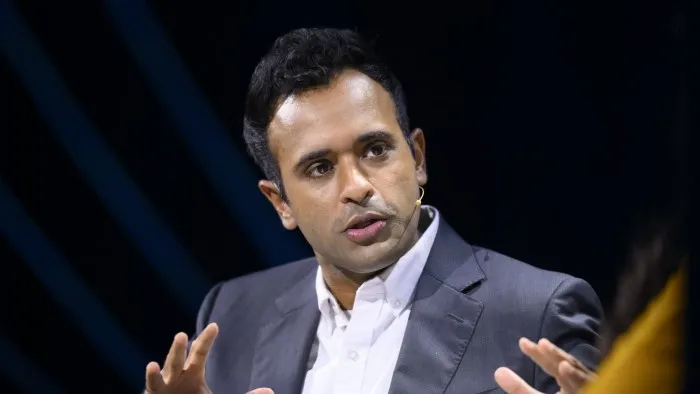Featured
Why Vivek Ramaswamy is Right About Climate Change
The current climate change agenda is more a tool of control than a genuine effort to combat environmental issues.

In the ever-evolving discourse on climate change, skepticism often finds little room. Yet, in a world where narratives shape policies and futures, it’s imperative to examine these narratives critically. Vivek Ramaswamy, a prominent figure in this debate, posits a thought-provoking perspective: the current climate change agenda, as it stands, is more a tool of control than a genuine effort to combat environmental issues. This view, while contentious, merits a closer look, especially in light of the historical context of climate alarmism.

Vivek Ramaswamy, one of the leading Republican Candidates behind Donald Trump, holds a controversial stance, asserting that the current climate agenda is more about political control than environmental concern. He boldly declares, “The climate change agenda is a hoax,” a statement he has repeated emphatically to underscore his skepticism towards prevailing climate policies. Ramaswamy argues that the repercussions of these policies are more detrimental than the environmental issue they aim to address, stating, “More people are dying of bad climate change policies than they are of actual climate change”. This perspective positions him as a challenging voice in the climate debate, questioning the motives and efficacy of the policies and initiatives being promoted in the name of climate action. Let me explain why I agree with him.
Rewind to the 1960s and 70s. The environmental concern du jour was an impending ice age, a narrative as alarming then as global warming is today. The shift from a fear of freezing to overheating prompts questions about the consistency and reliability of these catastrophic predictions. It’s not the science of climate change that’s in question here; rather, it’s the portrayal and use of this science in public discourse and policy-making.
Ramaswamy’s argument gains further traction when considering the actions of some climate change advocates. High-profile figures and politicians, who vociferously warn of rising sea levels and catastrophic weather changes, often contradict their public stances in their private lives. Private jets, extensive air travel, and luxurious lifestyles with substantial carbon footprints mark a stark contrast to their public advocacy. A notable example is the purchase of seafront properties by those who profess an imminent threat to such locales. This dichotomy raises legitimate questions about the sincerity and integrity of their environmental concern.
Here are a few examples:

1. Leonardo DiCaprio: An outspoken advocate for environmental issues, DiCaprio has faced criticism for his use of private jets and yachts, modes of transportation with high carbon footprints. Despite his advocacy, these personal choices have been seen as inconsistent with his environmental activism.

2. Al Gore: The former U.S. Vice President and environmental activist, known for his work on climate change awareness, has been critiqued for his substantial energy consumption. Reports have highlighted the high electricity usage of his mansion in Tennessee, which contrasts with his call for energy conservation.

3. John Kerry: As a prominent figure in climate change diplomacy, Kerry has been criticized for his use of private jets. This was particularly highlighted when he took a private jet to accept an environmental award in Iceland, raising questions about the carbon footprint associated with such travel.

4. Barack and Michelle Obama: Despite expressing concerns about climate change and rising sea levels, the Obamas purchased a substantial property on Martha’s Vineyard, an area potentially vulnerable to sea level rise. This move has been pointed out as potentially contradictory to the climate risks they have articulated.
This leads to a broader, more unsettling implication: Is the climate change agenda being wielded as a tool for broader societal and economic control? Policies and initiatives born from this agenda often have far-reaching impacts, affecting everything from energy consumption to housing and transportation. While the intent may be to promote sustainability, there’s an underlying narrative that merits scrutiny. Are these policies truly about saving the planet, or about controlling economic and social behaviors?
The Cudgel of “The 97%”:
When discussing the widely cited statistic that over 90% of scientists agree on human-caused climate change, it’s crucial to delve beyond the surface and understand the complexities behind this number. This figure, often referenced in debates and policy discussions, originates from studies like the one led by John Cook in 2013, which reviewed thousands of scientific papers and concluded that a vast majority endorsed the anthropogenic climate change view. However, the interpretation and implications of this statistic warrant a closer examination.
Firstly, the methodology of these studies is a point of contention. Critics argue that the process of categorizing and interpreting scientific papers or statements might introduce biases or oversimplifications. For instance, how researchers determine what constitutes agreement with the consensus can vary, potentially skewing the results. This methodological critique calls for a careful assessment of how such studies are conducted and how their conclusions are drawn.

Furthermore, the nature of scientific understanding is inherently dynamic. Science progresses through continuous questioning, testing, and revising of ideas. By focusing on a fixed percentage, there’s a risk of portraying scientific consensus as static, potentially stifling ongoing research and discussion. It’s essential to recognize that what is considered a consensus today might evolve tomorrow as new evidence emerges.
The diversity of opinions within the field of climate science also needs acknowledgment. While there’s broad agreement on the basic premise of climate change and its human-induced causes, there is more debate and discussion regarding its severity, pace, and the most effective responses. The “90% agreement” figure can sometimes obscure these nuances, presenting a unified front that doesn’t fully represent the range of scientific perspectives.
Moreover, the translation of this statistic into public discourse is another area for scrutiny. Simplifying complex scientific discussions into a single percentage figure for broader public consumption can be misleading. It’s crucial for the public to understand the nuances and complexities of scientific debates, rather than relying on a distilled and potentially oversimplified statistic.

In conclusion, Vivek Ramaswamy’s assertion that the climate change agenda is more of a political tool than an environmental crusade resonates for several compelling reasons. Firstly, the inconsistency between the public advocacy and private actions of some high-profile climate activists raises questions about the sincerity of the mainstream environmental movement. When celebrities and politicians who champion drastic measures against climate change engage in high-carbon-footprint lifestyles, it undermines the message and suggests potential hypocrisy.
Secondly, the debate around the widely cited statistic that over 90% of scientists agree on human-caused climate change merits attention. This figure, while powerful, can oversimplify the complexities and nuances of scientific discourse, potentially stifling open-ended inquiry and debate. Ramaswamy’s skepticism towards such blanket statements aligns with the need for a more nuanced understanding of scientific consensus and the dynamic nature of scientific research.
Ramaswamy’s perspective challenges us to scrutinize the motivations and implications behind the climate change narrative. It is not a call to dismiss environmental concerns but an invitation to engage in more honest, transparent, and effective discourse. As we navigate these complex issues, it’s imperative that we maintain a balance between environmental responsibility and critical examination of the policies and narratives shaping our world. Only through such thoughtful and informed discussion can we hope to arrive at solutions that are genuinely beneficial for both our planet and its inhabitants.
Stay Vigilant!
-

 News3 days ago
News3 days agoWho’s Really in Charge? Biden Says He’s Not Commander-in-Chief
-

 News1 day ago
News1 day ago“I Was Shot”: Trump Responds After Assassination Attempt; Shooter Dead; Secret Service Reportedly Ignored Warnings
-

 News1 day ago
News1 day agoJust 3 Months Ago Democrats Introduced a Resolution to Strip Trump of His Secret Service Protection
-

 News21 hours ago
News21 hours agoRFK Jr.: ‘Trump Assassination Attempt Mirrors JFK’s’























